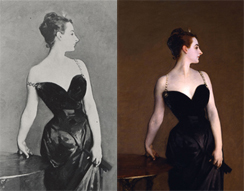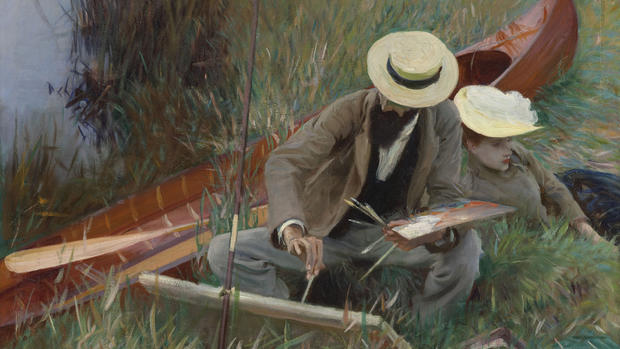John Singer Sargent's portraits of artists and friends
"A Portrait Of The Artist" is a doubly meaningful phrase when the artist in question was himself a master of the portrait ... as Martha Teichner now shows us:
Her name was Virginie Gautreau, but scandal turned her forever into "Madame X," and just about did in the career of 28-year-old John Singer Sargent when he exhibited her in 1884, and shocked Paris with her provocative pose.
"The great story behind this painting is that in the original version, he accentuated her sensuality even more by dropping the strap off her right shoulder," said Betsy Kornhauser, co-curator of a recent exhibition of Sargent portraits at the Metropolitan Museum of Art in New York City.
"He decided to paint it back, and he would keep the painting for the rest of his life until he finally offered it to the Metropolitan Museum of Art in 1907. And at the time, he stated that he felt it was his finest work."
That's saying something for an artist who, at 23, dazzled Paris with a portrait of his teacher ... and at 24, with his painting of Madame Ramon Cubercaseaux ... and at 25, with a huge portrait of Parisian gynecologist and playboy Dr. Samuel Pozzi, considered a masterpiece.
Sargent was born in 1856 in Florence, Italy, to American parents, and he spent his entire childhood growing up in Europe.
"He grows up in a really kind of cultured world," said Stephanie Herdrich, another of the Met show's curators. "[He's] exposed to many different cities, towns, museums. He grows up to be fluent in English, Spanish, French, Italian, and he speaks German. He's a very talented musician in his own right, playing the piano."
Think Gilded Age, that glittering era of sophistication and new money at the end of the 19th century. John Singer Sargent painted and lived it. He cultivated commissions from its rich, and became famous for his luscious, flattering, society portraits, which is exactly what critics often held against him.
"For a very long time, he was defined by his commissioned works," said Kornhauser, "and he was defined by the people that he painted. I think that was very unfair."
His reputation, according to Kornhauser, is undergoing a radical re-evaluation. "John Singer Sargent, beyond being the most talented and celebrated portrait painter of his day, I think looking back in time, we could say that he was one of the greatest artists of all time," she said.
The evidence: His much more intimate paintings of people within his own circle, many of them provocative or famous cultural figures -- friends, fellow artists, writers and painters he didn't need to flatter. "Exactly," said Kornhauser. "He could go deeper and pull out really profound character traits and very often reveal his feelings about the person."
He loved painting other painters painting, singers singing, actors acting.
In his 1890 painting "La Carmencita" (who was a well-known Spanish dancer of the period), Sargent is channeling the old masters. But in an oil sketch, in which he tries to capture her in motion, as Sargent saw her performing in a New York City music hall.
At the time, Sargent's style was considered daring, unconventional, especially his paintings of friends, such as Robert Louis Stevenson, the author of "Treasure Island"; and the French Impressionist Claude Monet.
Monet is pictured seated on his artist's stool, holding a palette, working on a painting that is now in the Museum of Fine Arts, Boston.
"The detail that Sargent presents here has become of great significant because it's a pure Impressionist palette," said Kornhauser. "And this was precisely what Sargent was attempting to absorb and embrace at this time."
He did so extravagantly, especially once he moved to Britain to recover from the "Madame X" fiasco.
And over time, the go-to portrait painter of his day lost interest in the grand paintings that made his name, preferring people in informal settings, and watercolors regarded as some of the finest ever painted.
"In 1907, he makes a formal declaration 'I'm not painting any more portraits,'" said Herdrich. "Occasionally, he gets lured out of that for a very prominent commission, but he's got other interests in this period, and he's kind of painting what he wants to paint in this period."
And yet, 90 years after his death, in 1925, it is those extraordinary, telling portraits that are treasured all over the world.
The strange thing is, John Singer Sargent almost never painted himself. His only self-portraits were commissioned by others -- and reveal nothing about him.
- GALLERY: Masterworks of John Singer Sargent
For more info:
- "Sargent: Portraits of Artists and Friends" at the Metropolitan Museum of Art, New York (now closed)
- Exhibition catalogue: "Sargent: Portraits of Artists and Friends" by Richard Ormond and Elaine Kilmurray


